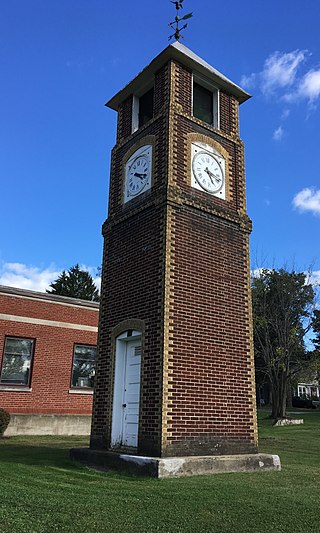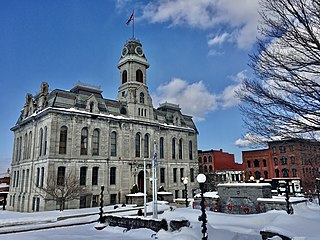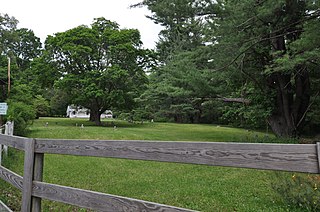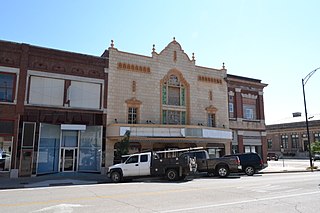
Fulton is a city in the western part of Oswego County, New York, United States. The population was 11,896 as of the 2010 census. The city is named after Robert Fulton, the inventor of the steamboat.

List of the National Register of Historic Places listings in Oswego County, New York

John Adolph Emil Eberson was an Austrian-American architect best known for the development and promotion of movie palace designs in the atmospheric theatre style. He designed over 500 theatres in his lifetime, earning the nickname "Opera House John". His most notable surviving theatres in the United States include the Tampa Theatre (1926), Palace Theatre Marion (1928), Palace Theatre Louisville (1928), Majestic Theatre (1929), Akron Civic Theatre (1929) and Paramount Theatre (1929). Remaining international examples in the atmospheric style include both the Capitol Theatre (1928) and State Theatre (1929) in Sydney, Australia, The Forum (1929), Melbourne, Australia), the Lewis J. Warner Memorial Theater (1932) at Worcester Academy in Worcester, Massachusetts and Le Grand Rex.

The Coliseum Theater, a former cinema in Seattle, Washington, opened January 8, 1916. It was listed on the National Register of Historic Places in 1975, and is also an official Seattle city landmark. Designed by B. Marcus Priteca, it was Seattle's first theater built specifically for showing movies, and was one of the first cinemas anywhere to strive for architectural grandeur. When it opened, it was advertised as "the world's largest and finest photoplay palace." In 1931, the Journal of the Royal Institute of Architects called it "the first of the world's movie palaces."

State Theatre of Ithaca is a historic, 1600-seat theatre located at Ithaca in Tompkins County, New York that hosts various events from bands, to plays, to comedy acts, to silent films, and more.

Lacona Clock Tower is a historic clock tower located at Lacona in Oswego County, New York. It was built in 1925 and is a freestanding three-tier red brick tower with a square plan and pyramidal roof. The second stage features the working electric clock and third stage a belfry containing the village bell.
Samuel Sadler House is a historic home located at Sandy Creek in Oswego County, New York. It was built about 1870 and is a 2-story, red brick Italianate-style structure consisting of a 2-story, three-bay main block and 1+1⁄2-story, four-bay side wing and 1-story rear wing. Also on the property is a contemporary carriage house.

Oswego City Hall is a historic city hall located at Oswego in Oswego County, New York. It was built in 1870 and is a 2+1⁄2-story masonry, mansarded structure with a distinctive central clock tower. It was designed by architect Horatio Nelson White (1814–1892).
U.S. Customhouse is a historic customhouse located at Oswego in Oswego County, New York. It is a three-story, flat roofed, rectangular stone building flanked by identical two-story wings. The original structure was built in 1858 and the wings added in 1935. It was designed by architect Ammi B. Young (1798–1874).

Oswego County Courthouse is a historic courthouse located at Oswego in Oswego County, New York. It was built in 1859-1860 and altered in 1891 and again in 1962. The two story building rises above a cruciform plan and is constructed of load bearing masonry walls faced with smooth ashlar limestone. It features a portico surmounted by a domed cupola. It was designed by architect Horatio Nelson White (1814–1892).

Oswego Armory is a historic National Guard armory located at Oswego in Oswego County, New York. It is a brick and stone castle-like structure built in 1906–1908. It was designed by State architect George L. Heins. It consists of a 2+1⁄2-story administration building with an attached large, gable-roofed drill shed. The building features a 5-story octagonal tower at the northwest corner.
Mount Adnah Cemetery is a historic rural cemetery located at Fulton in Oswego County, New York. It was designed in 1853 and within the boundaries of this contributing site are two contributing buildings, 10 contributing structures, and five contributing objects. Notable burials include M. Lindley Lee (1805–1876) and Albert Lindley Lee (1834–1907).
Riverside Cemetery is a historic rural cemetery and national historic district located at Oswego in Oswego County, New York. It was established in 1855 and designed by landscape architect Burton Arnold Thomas (1808–1880). Within the boundaries of this contributing site are six contributing buildings, 12 contributing structures, and 18 contributing objects. Notable burials include De Witt Clinton Littlejohn (1818–1892), Luther W. Mott (1874–1923), Newton W. Nutting (1840–1889), Joel Turrill (1794–1859), David P. Brewster (1801–1876), Rudolph Bunner (1779–1837), James Cochran (1769–1848), John C. Churchill (1821–1905), Leander Babcock (1811–1864), Abraham P. Grant (1804–1871), and Orville Robinson (1801–1882).
Volkert Van Buren House is a historic home located near Fulton in Oswego County, New York. It is a Federal style structure constructed about 1832.

Richardson-Bates House is a historic home located at Oswego in Oswego County, New York. It is constructed primarily of brick and built in two stages. The main section is a 2+1⁄2-story, Tuscan Villa style brick residence with a gable roof and 4-story tower designed by architect Andrew Jackson Warner about 1867. The interior features carved woodwork by Louis Lavonier. The South wing addition included a private library, formal dining room and kitchen that was completed in 1889.
George B. Sloan Estate is a historic home located at Oswego in Oswego County, New York. It is a 2+1⁄2-story, irregularly massed, Ithaca limestone building built between 1866 and 1870 in the Italian Villa style. It features a square, 3-story engaged tower. Also on the property is a carriage house, cast-iron fence, and fountain.

Oswego Meeting House and Friends' Cemetery is a historic Society of Friends meeting house and cemetery in Moore's Mill, Dutchess County, New York. It was built in 1790 and is a 1+1⁄2-story frame building sided with clapboards and wooden shingles. It has a moderately pitched gable roof and two entrances on the front facade, each flanked by two windows. The cemetery contains about 50 stones and burials range in date from the 1790s to 1880s. Also on the property is a privy.

The Tower Theatre for the Performing Arts is a historic Streamline Moderne mixed-use theater in Fresno, California. Built in 1939, it opened to the public on December 15, 1939, under the management of Fox West Coast Theater Corporation. The building was designed by S. Charles Lee, with its tower inspired by the "Star Pylon" at the 1939 New York World's Fair. The theater underwent a renovation and reopened as a performing arts center in 1990, after being closed as a repertory cinema in 1989 due to financial troubles.

The Booth Theater is a historic movie theater located at 119 W. Myrtle St. in Independence, Kansas. The building was constructed in 1911 and renovated for use as a movie theater in 1926–27. The redesigned theater was the first in Independence to be designed specifically for use as a movie theater. The Boller Brothers, an architectural firm known for their theater designs, designed the theater in a mixture of the Spanish Renaissance and Italian Renaissance Revival styles. The theater showed films until its closure in 1980.

Queens Theatre, formerly Queens Theatre in the Park and before that Queens Playhouse, is an American professional theatre, located in Flushing Meadows–Corona Park, Queens, New York City, New York. Artistic and Executive Directors have included Joseph S. Kutrzeba, founder and producer; Robert Moss, Sue Lawless, Jeffrey Rosenstock and Ray Cullom, formerly Managing Director of Long Wharf Theatre in New Haven, CT, and currently, Taryn Sacramone, former Executive Director of Astoria Performing Arts Center.


















